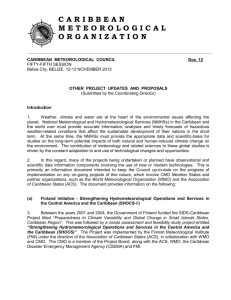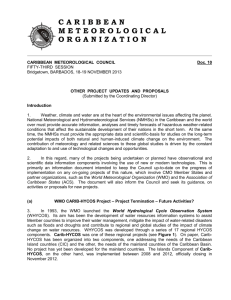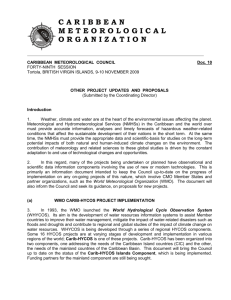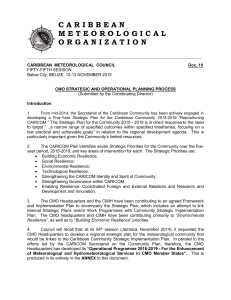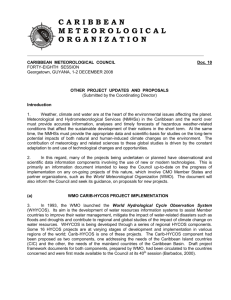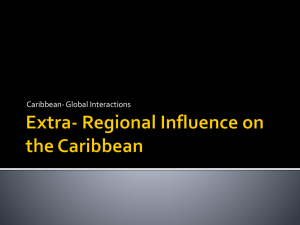CMC54 Doc 10 - Caribbean Meteorological Organization
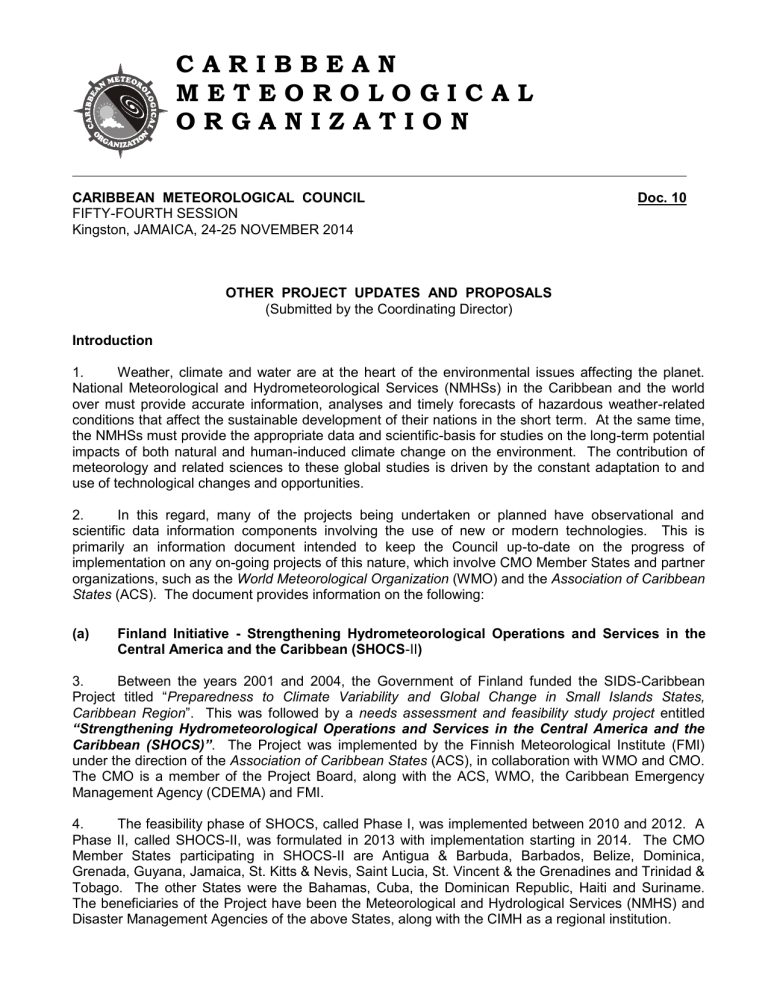
C A R I B B E A N
M E T E O R O L O G I C A L
O R G A N I Z A T I O N
CARIBBEAN METEOROLOGICAL COUNCIL
FIFTY-FOURTH SESSION
Kingston, JAMAICA, 24-25 NOVEMBER 2014
Doc. 10
OTHER PROJECT UPDATES AND PROPOSALS
(Submitted by the Coordinating Director)
Introduction
1. Weather, climate and water are at the heart of the environmental issues affecting the planet.
National Meteorological and Hydrometeorological Services (NMHSs) in the Caribbean and the world over must provide accurate information, analyses and timely forecasts of hazardous weather-related conditions that affect the sustainable development of their nations in the short term. At the same time, the NMHSs must provide the appropriate data and scientific-basis for studies on the long-term potential impacts of both natural and human-induced climate change on the environment. The contribution of meteorology and related sciences to these global studies is driven by the constant adaptation to and use of technological changes and opportunities.
2. In this regard, many of the projects being undertaken or planned have observational and scientific data information components involving the use of new or modern technologies. This is primarily an information document intended to keep the Council up-to-date on the progress of implementation on any on-going projects of this nature, which involve CMO Member States and partner organizations, such as the World Meteorological Organization (WMO) and the Association of Caribbean
States (ACS). The document provides information on the following:
(a) Finland Initiative - Strengthening Hydrometeorological Operations and Services in the
Central America and the Caribbean (SHOCS -II )
3. Between the years 2001 and 2004, the Government of Finland funded the SIDS-Caribbean
Project titled “
Preparedness to Climate Variability and Global Change in Small Islands States,
Caribbean Region ”. This was followed by a needs assessment and feasibility study project entitled
“Strengthening Hydrometeorological Operations and Services in the Central America and the
Caribbean (SHOCS) ” . The Project was implemented by the Finnish Meteorological Institute (FMI) under the direction of the Association of Caribbean States (ACS), in collaboration with WMO and CMO.
The CMO is a member of the Project Board, along with the ACS, WMO, the Caribbean Emergency
Management Agency (CDEMA) and FMI.
4. The feasibility phase of SHOCS, called Phase I, was implemented between 2010 and 2012. A
Phase II, called SHOCS-II, was formulated in 2013 with implementation starting in 2014. The CMO
Member States participating in SHOCS-II are Antigua & Barbuda, Barbados, Belize, Dominica,
Grenada, Guyana, Jamaica, St. Kitts & Nevis, Saint Lucia, St. Vincent & the Grenadines and Trinidad &
Tobago. The other States were the Bahamas, Cuba, the Dominican Republic, Haiti and Suriname.
The beneficiaries of the Project have been the Meteorological and Hydrological Services (NMHS) and
Disaster Management Agencies of the above States, along with the CIMH as a regional institution.
CMC54 , Doc 10, page 2
5. The Overall Purpose of SHOCS II is:
To e nhance the role and strengthen the capacity of National Meteorological and Hydrological
Institutions and Disaster Management Agencies in ACS Member States in the provision of early warning services and preparedness to mitigate impacts of natural hazards.
6. SHOCS II comprises four themes. Implementation results achieved so far in 2014 are listed:
Result 1: Improved operational capacity of the Caribbean NMHSs weather observation network.
Activities include:
(i) Enhancement of Automatic Weather Station (AWS) networks (including the acquisition of, or upgrade to non-corrosive AWS technology);
(ii) Enhancing tools for weather forecast production at selected NMHSs
SmartMet workstations: 3 Main Sites and 7 or 8 Remote Sites
Main Sites: Cuba, Barbados and Antigua & Barbuda
Remote Sites: Belize, Guyana, Grenada and Saint Lucia. A decision on other potential remote sites is to be made after further analysis.
(iii) Enhancing communication of climate information to the Caribbean communities
Virtual climate services’ Internet portal focusing on the Caribbean region, to be developed in cooperation with CIMH and other regional institutes in support of CIMH’s role as a WMO Regional Climate Centre.
Results achieved in 2014:
- Hardware and software designed for data retrieval, data quality control and metadatabase;
- Assessment of AWS in Cuba and the Dominican Republic;
- SmartMet Installation and initial training for Cuba and the Dominican Republic.
Result 2: Improved capacity for communication of risk information and early warnings by NMHSs and
DMAs
(i) Capacity building on institutional governance through Quality Management;
(ii) Coordination between NMHSs and Disaster Management Agencies (DMAs);
(iii) Workshop on regional coordination of Early Warning System (EWS) products, etc;
(iv) Introduction of relevant protocols, such as the Common Alerting Protocol (CAP), etc.;
(v) Enhancing TV broadcasting presentation skills of Early Warning information.
Results achieved in 2014:
-
-
Preparation of a stand-alone software solution for real-time management and issuing of weather warnings for NMHSs (or DMAs). The software will produce messages in XML format compatible with Common Alerting Protocol standard. Pilot NMHSs selected for testing the software are Cuba, Antigua and Barbuda and Jamaica. The software was ready for test use from September 2014.
An open tender on the TV broadcasting solution was launched in June 2014. Installation and initial training in Cuba was targeted for November-December 2014, outside of the hurricane season. Training workshops are planned during the early part of 2015 for the
TV presenters from other Caribbean NMHSs.
CMC54 , Doc 10, page 3
7. In mid-2014, there was a change in the Project Manager by the Finnish Meteorological Institute
(FMI). In 2015, it is hoped that the momentum will be maintained in the implementation of other areas within the Project that are yet to be carried out.
(b) Lightning Detection System
8. Council will recall that the CMO Headquarters has, for some time, studied the possibility of establishing a ground-based Lightning Detection System in the region. The CMO Headquarters is of the opinion that such a system is very necessary in the Caribbean. The 52 nd session of the Council
(November 2012) was provided with a visualization of a long-range lightning detection system, which provides data over the oceanic areas associated with weather systems that are well outside of radar range. At the shorter distances, however, higher accuracy and thus a high resolution detection are both necessary, especially if lightning data is required for specific sensitive locations and activities.
Although the long-range systems still provide very useful information at the shorter ranges, they are best used in conjunction with short-range systems. Therefore, for this higher resolution to be achieved, it would be necessary to install some lightning sensors along the island chain to allow for adequate triangulation usi ng the commonly known phenomenon “lightning spherics”.
9. In 2013, to demonstrate the value of long-range lightning detection and location systems, the
CMO Headquarters organized with the Vaisala company of Finland, a free real-time operational
“field” trial , lasting several months and covering the Caribbean, northern parts of South America and the Atlantic Ocean as a subset of its global system. A sample of the regional lightning detection during the trial, which was show n at the Council’s 53 rd session in November 2013, is again shown in Figure 1 below.
10. There are three basic options for consideration for an island-chain set of ground-based sensors;
(i) the number and location of processing units for the data; (ii) the mode of transmission among the countries involved and (iii) the method of paying for the system. A further issue for consideration is to build onto existing lightning systems owned by non-regional entities and then subscribe to the service, as is done by many countries. The CMO Headquarters has considered the costs proposed by some of the vendors. To-date, no realistically affordable solution for the CMO Member States has been identified . However, efforts in this regard will continue.
11. It is also important to note, as discussed in CMC54 Doc.5, that the next generation of the
Geostationary Operational Environmental Satellite R-series ( GOES-R ) will include a new capability for total lightning detection (in-cloud and cloud-to-ground flashes) from the Geostationary Lightning Mapper
(GLM). However, the current planned launch of the first GOES-R series is early 2016. The first
GOES-R will be placed in orbit in the new western position at 137 °W (not 135°W as today's
GOES-West). The footprint of a satellite at 137°W will only cover the Western Caribbean. It will be a few years later before the second new satellite (GOES-S) will be operational in the eastern position at
75°W. It will therefore be sometime before satellite-based lightning detection is fully available.
Notwithstanding these facts, it is not envisaged that the accuracy of short-range lightning detection by satellite will be as good as ground-based systems.
CMC54 , Doc 10, page 4
Figure 1
: Vaisala’s Global Lightning Detection System (August 2013)
CMC54, Doc 10, page 5
(c) Other CMO Project Proposals
(i) Regional component of the WMO Integrated Global Observing System (WIGOS)
12. Under Agenda Item 5, Council was provided with the latest plans for implementation of the
Region's component of the WMO Integrated Global Observing System (WIGOS). WIGOS is an allencompassing approach to the improvement and evolution of WMO’s global observing systems.
The i mplementation of the WIGOS is very closely related to the new WMO Information System
(WIS), both of which are essential to all technical and scientific activities of Meteorological Services in the Caribbean and worldwide. The CMO Headquarters plays a major regional and international role in the implementation of WIGOS and WIS.
(ii) A Caribbean initiative in the field of early warning systems, integrating Carib Risk
Cluster objective
13. Since 2013, the Caribbean Meteorological Organization has been collaborating with the
Meteorological Service of France ( Météo-France) under a European Union-funded project entitled
“ Caribbean Cluster on Natural Risks and Risks from the Sea ”, (acronym Carib Risk Cluster ).
The Project is being implemented by the General Council of Martinique.
14. A major component of the Carib Risk Cluster project is the implementation of Météo-France
“ SHERPA ” initiative. SHERPA’s aims are:
Improving the availability of upfront meteorological expertise, made available to
Météo-France, for exclusive use by neighbouring Caribbean National Meteorological
Services, including Haiti.
Setting up an exchange platform, in real time, to improve coordination between neighbouring Caribbean territories, for a better management of extreme meteorological events, especially outside or on the periphery of tropical cyclones.
15. SHERPA is a secured WEB platform (Extranet) to share and make available products and information useful to the analysis, and to the forecasting of potentially dangerous meteorological phenomena in the Caribbean, including
Products to improve the use of observation data (radars, wave riders, satellite imagery…);
Numerical Weather Products based on the French models (ARPEGE/ALADIN) and on the ECMWF models.
16. The collaboration between Météo France and CMO is intended, among other things, to:
-
Promote the SHERPA initiative, within Carib Risk Cluster, to the CMO Member
States;
-
Help partners define and put in place support necessary to the implementation of
Extranet SHERPA;
-
Ensure feedback of information from NMHS in CMO Member States;
-
Take measures to ensure the non-redistribution of shared Extranet data or products without prior consent from Météo France.
CMC54, Doc 10, page 6
17. The NMHSs in CMO Member States and the Organs of the CMO have access to other platforms that may have a similar purpose as SHERPA. However, the use of SHERPA is encouraged as a tool for meteorologists in the forecast and warning process, and as a common platform that could be used for coordination among NMHSs in the process. CMO Headquarters and
Météo France will continue to examine ways to increase and refine the utility of SHERPA in the region.
(iii) An Education and Training initiative – The GLOBE Program
18. At the 53 rd session, the Council was informed of the Global Learning and Observations to
Benefit the Environment (GLOBE) program , which is a worldwide hands-on, primary and secondary school-based science and education program. GLOBE's vision promotes and supports students, teachers and scientists to collaborate on inquiry-based investigations of the environment and the Earth system, working in close partnership with the National Aeronautics and Space
Administration (NASA), the National Oceanic and Atmospheric Administration (NOAA) and the
National Science Foundation (NSF) of the USA in the study and research about the dynamics of
Earth's environment.
19. Through the GLOBE Program, NASA and the World Meteorological Organization (WMO) are working together to enhance general public understanding of weather, water and issues such as climate change. Initial plans for collaboration include involving National Meteorological and
Hydrological Services (NMHSs) in the implementation of regional GLOBE Program activities, such as teacher training events and working with schools that lack access to computer technology.
20. Council was informed of the interest of the CMO Headquarters to introduce the GLOBE
Program to high schools in the region, in which they could run simple weather/climate stations and receive some basic instructions from the Met Services. Little progress has been made in 2014 in pushing this idea forward, but efforts are continuing.
ACTION PROPOSED TO COUNCIL
21. The Council is invited to :
Note the updated information and provide any guidance necessary on (i) The Finlandfunded Project for the Strengthening Hydrometeorological Operations and Services in the Central America and the Caribbean (SHOCS II), (ii) Lightning Detection System and
(iii) other projects planned by or involving the CMO Headquarters.
___________
CMO Headquarters
October 2014
